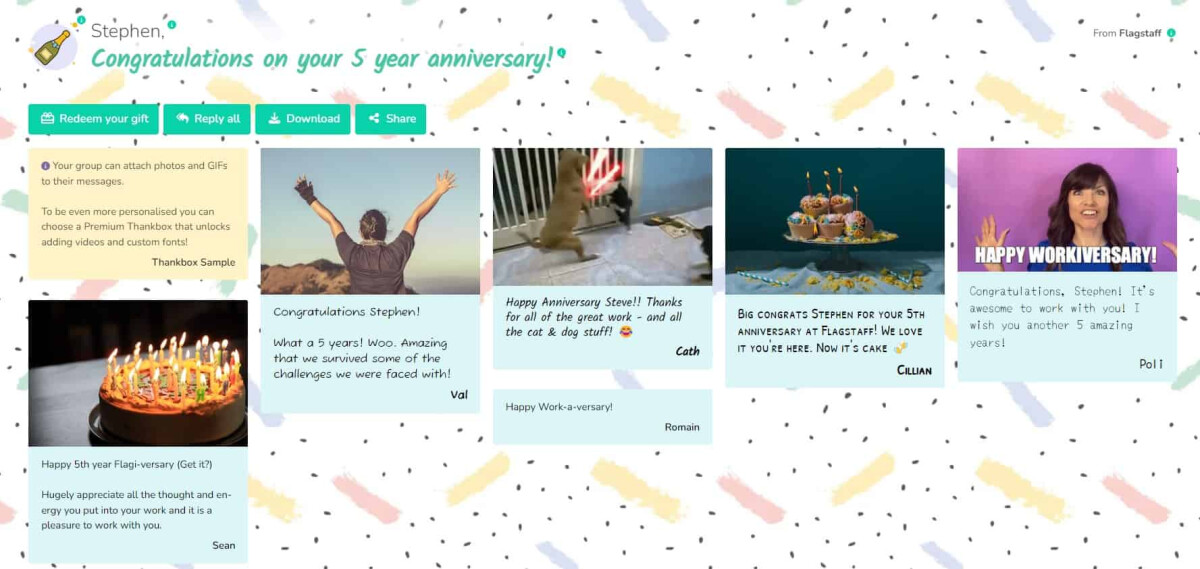The Art of Active Listening: Enhancing Communication and Understanding at Work


Have you ever been stuck in one of those meetings where everyone's playing a high-stakes game of “Who Can Pretend to Listen the Best?” We’re so eager to get our points across that we sometimes forget we have two ears but only one mouth for a reason.
Active listening plays a massive role in workplace dynamics. This isn’t your general nod-and-smile routine — active listening is like a superpower that transforms you into the ultimate partner, teammate, or supervisor.
This article from Thankbox offers 20 techniques to improve your active listening skills, turning you into an effective communicator, better team player, and more empathetic individual.
Ready to transform your company values and work environment? Let’s dive in!
Why active listening is a game-changer
Become a leader people rally behind: Active listening elevates your leadership capabilities and interpersonal connections. From understanding non-verbal cues to showing empathy, active listening turns you into the leader people want to follow.
Build a more unified team: Have you ever heard the saying, “Teamwork makes the dream work”? Well, active listening is the secret sauce. When people feel genuinely heard and understood, walls come down, and collaboration goes up.
Efficiency through active listening: Let’s cut to the chase — miscommunications are costly. Active listening fine-tunes your team’s communications, ensuring that messages hit the mark and there are no time-wasting misunderstandings.
Embrace active listening with Thankbox
Before we unlock the keys of active listening, how about a unique way to make your team feel heard and appreciated? Thankbox supercharges congratulations, goodbyes, and “just because” moments with innovative group personalisation and cutting-edge style.

Imagine sending an e-card with personal messages, GIFs, photos, and videos to a team member who's aced a project or someone leaving for a new opportunity. It’s certain to make a lasting impression. You can even organise gift cards with a single click.
What better way to demonstrate active listening than acknowledging and celebrating your team?
Recognise excellence, appreciate those who go the extra mile, celebrate invaluable contributions. A Thankbox quickly lets the whole team raise performance through personal and sincere communications - whatever the occasion. Get started in seconds.
The five keys of active listening you need to know
Understanding: Processing what the speaker is telling you.
Remembering: Being able to recall information.
Evaluating: Assessing the relevance and content of what is being said.
Responding: Engaging in meaningful dialogue.
Asking: Coming up with the right questions.
Now, let’s review some techniques you can use to put these concepts into practice.
Enhance active listening at work with these techniques
Ready to lift staff morale through the roof? Sharpen your pencils and perk up those ears as we dive into mastering active listening at the workplace.
Understanding

1. Focus on the speaker
Understanding begins when you give the speaker your undivided attention. Turn off notifications, put your phone down, and bring your mental focus to the room. Being present shows respect and helps catch details you might otherwise overlook.
2. Non-verbal cues
Did you know your body speaks volumes even when you're silent? Lean slightly forward, maintain eye contact, and nod at appropriate times. This body language subtly communicates that you're engaged in the conversation, helping improve peer-to-peer recognition.
3. Paraphrasing
Have you ever tried the “Telephone” game? Messages can get muddled. To ensure you're both on the same track, repeat what you've heard but in your own words. This confirms your understanding and allows the speaker to clarify (if needed).
Remembering

4. Take notes
Taking notes plays a vital role in active listening. Jotting down vital points during meetings helps retain information and offers a quick reference later. Bullet points or keywords usually do the trick.
5. Repetition
Repeating important details mentally as you hear them significantly boosts your memory retention. This technique is perfect during high-stakes conversations where the margin for error is thin.
6. Chunking
Instead of trying to remember a long list of tasks, break them down into smaller, more digestible “chunks”. For instance, you could categorise a ten-step plan into three broad phases if you need to remember it easily. Trust us, your brain will thank you.
Evaluating

7. Hold judgment
Put your inner critic on mute. Delaying judgment helps you understand the message and avoids breaking the conversational flow, minimising misunderstandings. Before offering your opinion, pause to uncover any nuances you may have missed.
8. Ask clarifying questions
Think of yourself as a subtle detective. Well-timed clarifying questions deepen your understanding and clear up any confusion. Let the other person finish their thoughts before you answer your questions.
9. Critical thinking
Engage your critical thinking skills to assess the logic, consistency, and credibility of what’s been said. Analysing the information allows you to separate fact from opinion and helps you form a well-grounded perspective.
Responding

10. Nodding and smiling
A genuine nod and a warm smile go a long way in showing you’re invested in the conversation. These simple gestures create a comfortable and open atmosphere where meaningful exchanges occur.
11. Mirroring
Remember the saying, “Imitation is the sincerest form of flattery?” Subtly mimicking the speaker's gestures, tone, or speech rate helps establish a deeper connection and employee recognition.
12. Feedback
Offering feedback is about more than just waiting for your turn to talk. Respectfully providing your thoughts encourages an open exchange of ideas and demonstrates that you've not only heard but are on the same wavelength.
Asking

13. Open-ended questions
Avoid making conversations feel like interrogations by using open-ended questions. Questions like, “How did that make you feel?” encourage the speaker to share more, enriching the dialogue.
14. Probing questions
Curious but cautious? Use probing questions like, “What led you to that decision?” to dig deeper without making the speaker feel cornered. Probing questions helps uncover hidden motives and feelings.
15. Reflective questions
Reflective questions like “It sounds like that was challenging for you. Is that accurate?” allow speakers to delve into their thoughts and feelings. They offer validation and lead to new insights.
Additional tips
Active listening in virtual meetings: Adapt your listening skills to the Zoom era to keep the virtual meeting energy high.
Cultural sensitivity: Understand that cultural background affects communication styles.
The power of silence: Know when to speak and when to listen.
Role of empathy: Cultivate empathy to understand the emotions behind the words.
Regular practice: Active listening is a skill that needs consistent development.
Reward active listening with Thankbox!
Implementing these strategies can revolutionise your relationships and take productivity to new heights. So don’t just hear – truly listen and watch the transformation unfold in your professional life.
Ready to make your team’s day and put your active listening skills to the test? Explore Thankbox to make it happen.
Create your first Thankbox and feel the difference it makes.
Recognise excellence, appreciate those who go the extra mile, celebrate invaluable contributions. A Thankbox quickly lets the whole team raise performance through personal and sincere communications - whatever the occasion. Get started in seconds.





